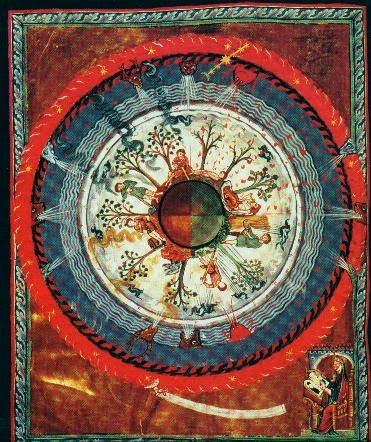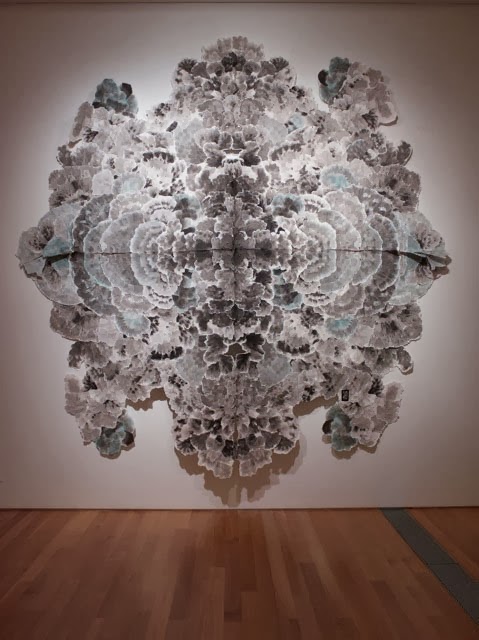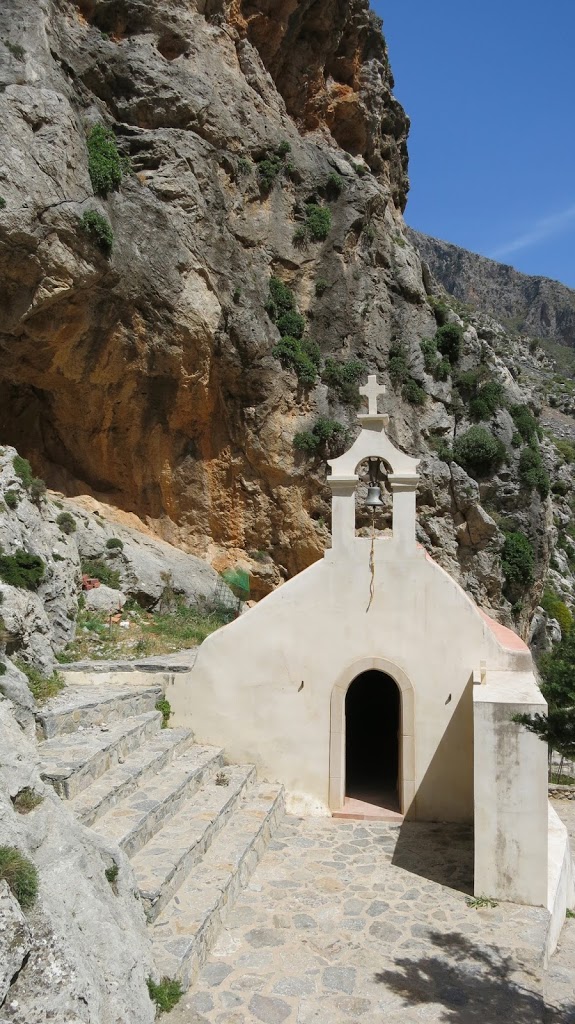East Meets West in Mandala Art
| Temporary floor mandala, flashed by light onto the floor of the Smithsonian’s Sackler Gallery of Asian Art |
Mandalas, an important tradition in India, Nepal and Tibet have spread well into the West, or as some think, have always been in the West. The exhibition, Yoga: The Art of Transformation at the Smithsonian’s Sackler Gallery of Art, takes us into art and history surrounding the physical, spiritual and spiritual exercise of yoga. It’s the first exhibition of its kind. This is the last weekend of the show, featuring works of art in Hindu, Jain and Buddhist practice. Yoga hold some keys to mental and physical healing.
We’re led into yoga’s 3,000-year history by a series of light patterns flashed on the floor–patterns that are mandalas and have lotus patterns. (Lotus is also the name of a yoga pose.) After this weekend, they’ll be gone with the show, but that’s the spirit of mandalas, at least in the Tibetan tradition.
| Light Pattern on the floor of the Sackler Gallery of Asian Art forms a Mandala |
Mandalas have radial balance, because their designs flow radially from the center, somewhat like the spokes of a wheel. Traditional Buddhist monks in Tibet spend time together making mandalas of colored sand, working from the center outward using funnels of sand that form thin lines. Deities are invoked during this process of creation, following the same ancient pattern of 2,500 years. The creation is thought to have healing influence. Shortly after its completion, a sand mandala is poured into a river to spread its healing influence to the world.
 |
|||
| Chenrezig Sand Mandala was made for Great Britain’s House of Commons in honor of the Dalai Lama’s visit in May, 2008. Material: sand, Size: 7′ x 7′ Source of photo: Wikipedia |
Like the Buddhist Stupas which began in India, the Mandalas are microcosms of the macrocosm, or small replicas of the universe. Yantras are mandalas that are an Indian tradition which may have a more personal meaning. Their beautiful geometric designs can be highly efficient tools for contemplation, concentration and meditations. Concentrating on a focal point, outward chatter ceases and the mind empties to gain a window into truth. Making mandalas can be a powerful aid in Art Therapy.
 |
| North Rose Window of Chartres Cathedral, France, c. 1235 |
Circles, without a beginning or end, have an association with God and perfection. They’re an integral part of the design of Gothic Cathedrals, such as Chartres Cathedral and Notre-Dame of Paris which are among the most famous. Their patterns radiate out from the center, into rose patterns. I didn’t believe it when, years ago, a student mentioned they were inspired by Indian mandalas. The greater possibility is that spiritual wisdom comes from the same or similar sources.
 |
| Sri Chakra Mandala, ceramic tile, made by Ruth Frances Greenberg 17-1/4″ x 17-1/4″ x 1-1/4′ photo Lubosh Cech |
Artist Ruth Frances Greenberg makes ceramic tile mosaic mandalas in her Portland, Oregon studio, and sells them for personal and decorative use. Some are inspired by the Om symbol and by the home blessing doorway mandalas of Tibet. Others are inspired by the Chakras, the energy centers in ancient Indian tradition. The Sri Chakra Mandala has nine interlocking triangles and beautiful geometric complexity. It combines the basic geometric shapes of circle, square and triangle, and expresses powerful energies.
 |
| Hildegard of Bingen, Wheel of Life, c. 1170, photo courtesy of Contemplative Cottage |
The circle within a square is common in many traditions, but in Indian art the openings of the square represent gateways. Leonardo da Vinci’s Vitruvian Man, a study of perfection in human proportions, has a circle within a square. Medieval mystic, St. Hildegard of Bingen, a Doctor of Church, wrote music and created art in response to her visions. Wheel of Life is one of her many visions that were put into illumination in the mandala form, in the 12th century.
Chicago artist Allison Svoboda makes mandalas from a surprising combination of media: ink and collage. She explains, “The same way a plant grows following the path of least resistance, the quick gestures and simplicity of working with ink allows the law of least resistance to prevail….With this process, I work intuitively through thousands of brushstrokes creating hundreds of small paintings. I then collate the work…When I find compositions that intrigue me, I delve into the longer process of collage. Each viewer has his own experience as a new image emerges from the completed arrangement. The ephemeral quality of the paper and meditative aspect of the brushwork evoke a Buddhist mandala.”
 |
| Allison Svoboda, Mandala, GRAM, 211–detail |
The 14′ by 14′ Mandala GRAM from the Grand Rapids Art Museum is a radial construction with many inner designs. Some of these designs resemble a Rorschach test, but infinitely more complicated.
The intricacies of the GRAM Mandala alternate and change as our eyes move around it. It’s like a kaleidoscope or spinning wheel. But a configuration in center pull us back in, reminding us to stay centered and whole, as the world changes around us.
 |
| Allison Svoboda, Mandala, GRAM, 2011, Grand Rapids Museum of Art, in on paper, collaged 14′ x 14′ |










Recent Comments